It’s not been all smooth sailing for Mattéo Guendouzi (185cm/6’1”, 68kg/150lbs), despite the PSG and Lorient youth academy product having been tipped for great things from a young age — even getting a high profile €8m move to EPL giants Arsenal while still but a teenager in 2018.
During his time as a gunner, Guendouzi made 82 appearances for the EPL side under Unai Emery, Freddie Ljungberg, and Mikel Arteta, respectively.
The majority of those games came under his first Arsenal coach, former PSG boss and current Villarreal manager Emery.
He was very young and still learning his trade, perhaps it was too big of a step up too soon, but things never materialised in the way they were supposed to according to the fairy tale at the Emirates Stadium for the young Frenchman, who fell out of favour at the North London club in quite a highly publicised way towards the end of his time there before being sent out on loan to Bundesliga side Hertha Berlin for the 2020/21 campaign, a stint that has been described as disappointing, and perhaps wasn’t one that was truly in the best interest of the young player.
At a sensitive stage of his development, Guendouzi’s next move after his Bundesliga experience was always going to be an important one.
This past summer, we saw the 22-year-old move back to his native France to join one of Ligue 1’s most historic clubs, Olympique de Marseille, on an initial loan move ahead of a permanent transfer in the summer of 2022.
Under renowned Marcelo Bielsa disciple Jorge Sampaoli, the young midfielder has been rejuvenated in Ligue 1 and, for my money, has been one of the most fun players to watch in France’s top flight this term, in addition to being one of the most effective creative midfielders in the league.
This tactical analysis and scout report aims to highlight how Guendouzi has been used by Les Olympiens this season.
In this analysis, I will highlight some of the most important details regarding Guendouzi’s role within Sampaoli’s strategy and tactics with the Provence-Alpes-Côte d’Azur-based side to explain why the 22-year-old has even managed to earn his first cap for the France national team in 2021/22.
Les Bleus boss Didier Deschamps recently declared that the midfielder has made ‘enormous progress’.
What’s Mattéo Guendouzi Position?
If you want more of an in-depth overview of Sampaoli’s tactics at Marseille, I covered them in some detail earlier this season for Total Football Analysis: Ligue 1 2021/22: Three tactical tweaks that spotlight Marseille’s evolution under Jorge Sampaoli – tactical analysis.
To summarise, though, Marseille, in possession, have primarily played in a 3-3-1-3 shape (which sometimes resembles more of a 3-5-2 with the ‘2’ being two wingers as opposed to two centre-forwards), while out of possession, they’ve mainly lined up in a 4-4-2 shape, though it’s worth noting that Sampaoli still engages in plenty of experimentation, especially depending on specific opponents who he feels his team can better exploit by adapting some aspects of their gameplan.
Within this offensive system, it’s common to see Guendouzi either playing as one of the two wide midfielders or as the ‘1’ behind the forward line.
Here, he can link up with the forward, who’ll often drop in between the lines, forming a system with essentially two number ‘10’s operating behind the forwards.
The most important thing to note on this particular point is that Guendouzi plays quite an offensive role at Marseille, with a large emphasis placed on progressing and creating via both passes and carries.
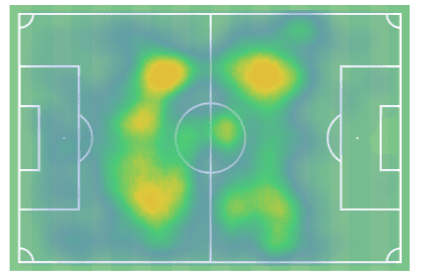
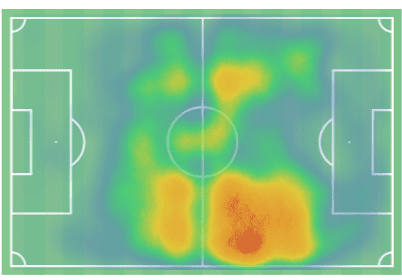
Compare figures 1 and 2.
Figure 1 shows Guenouzi’s heatmap from his final season at Arsenal, the 2019/20 campaign and figure 2 shows his heatmap from the 2021/22 campaign with Marseille.
We notice that he tends to spend more time in the opposition’s half of the pitch as opposed to his own half now, whereas the opposite was true in 2019/20.
Additionally, Guendouzi is getting much wider than he has in the past this season at Marseille.
The midfielder primarily plays in the right half-space when attacking, but he’s also often found all the way out on the right wing, providing width for his side as they enter the opposition’s half.
Regardless of whether he’s occupying the half-space or the wing, however, Guendouzi’s main aim when his team is in possession is to find space somewhere in his area of the pitch — which is typically the right side of the pitch as we see above — where he can be a viable passing option for his teammates.
Then, it’s all about receiving well, turning to face the opposition defence/goal and driving at them to create something for his team.
He should have progressive passers behind him, space around him and runners ahead of him.
This is when we’ve seen the best of Guendouzi this term, as he is given everything he needs to succeed in this system.
Mattéo Guendouzi Off-the-ball movement and passing
Guendouzi needs to create opportunities for himself to play opponents through on goal.
One way he does this is through his off-the-ball movement, finding space for himself to receive a teammate’s forward pass in enough time and space to turn, get his head up, and assess his options before making his next move.
Per Statsbomb via FBRef, the Frenchman has received an average of 57.56 passes per 90 this season, which ranks him in the 84th percentile among Ligue 1 midfielders for the 2021/22 campaign in this particular metric.
This metric highlights his heavy involvement in possession phases, with teammates often looking to find Guendouzi when progressing into the opposition’s half.
However, the 22-year-old’s ability to create space for himself to receive and make himself an attractive passing option is also vital here.
Additionally, Guendouzi is relatively heavily involved in the attacking third for Marseille, having made 21.3 touches per 90 in this third of the pitch this season, which ranks him sixth among all Marseille players.
He’s made 44 touches per 90 in the middle third, ranking him ninth among the aforementioned set of Marseille players this term, and he’s made just 10.2 touches per 90 in the defensive third — 14th among these Marseille players, indicating how Sampaoli doesn’t really want Guendouzi involved in build-up or even the early ball progression — instead, aiming to use his off-the-ball movement in these phases to be an option rather than a passer, looking to make him a link to the attacking third as he’ll then become a creator on the ball after receiving in the opposition’s half.
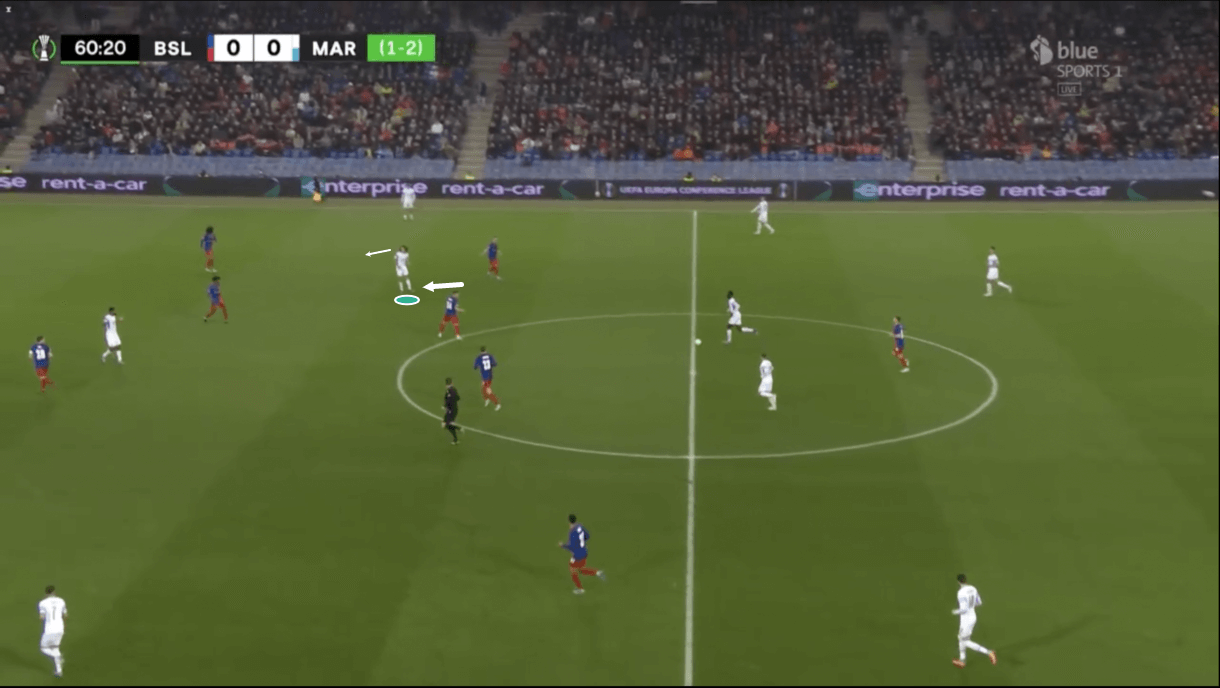
Figures 3-5 will show one particular passage of play that provides an example of Guendouzi moving to exploit space and make himself an attractive passing option for his teammate on the ball.
In Figure 3, we see the midfielder positioned in the right half-space while playing as the right central midfielder, peeling away from the shoulder of the opposition’s left midfielder, who’s covering this particular area of the pitch defensively.
While he backs off in the hope of making himself a better passing option for the midfielder carrying forward and just about to enter the opposition’s half, we see Guendouzi scanning to get a better picture of how the pitch looks behind his back to help his decision-making after receiving and turning to exploit this space, as well as make himself aware of any incoming pressure from behind as he backs into this space between the opposition’s midfield and defensive lines.
He intelligently chooses to scan in between the ball carrier’s heavy touches to ensure he doesn’t miss valuable developments on the ball by taking the time to check his shoulder.
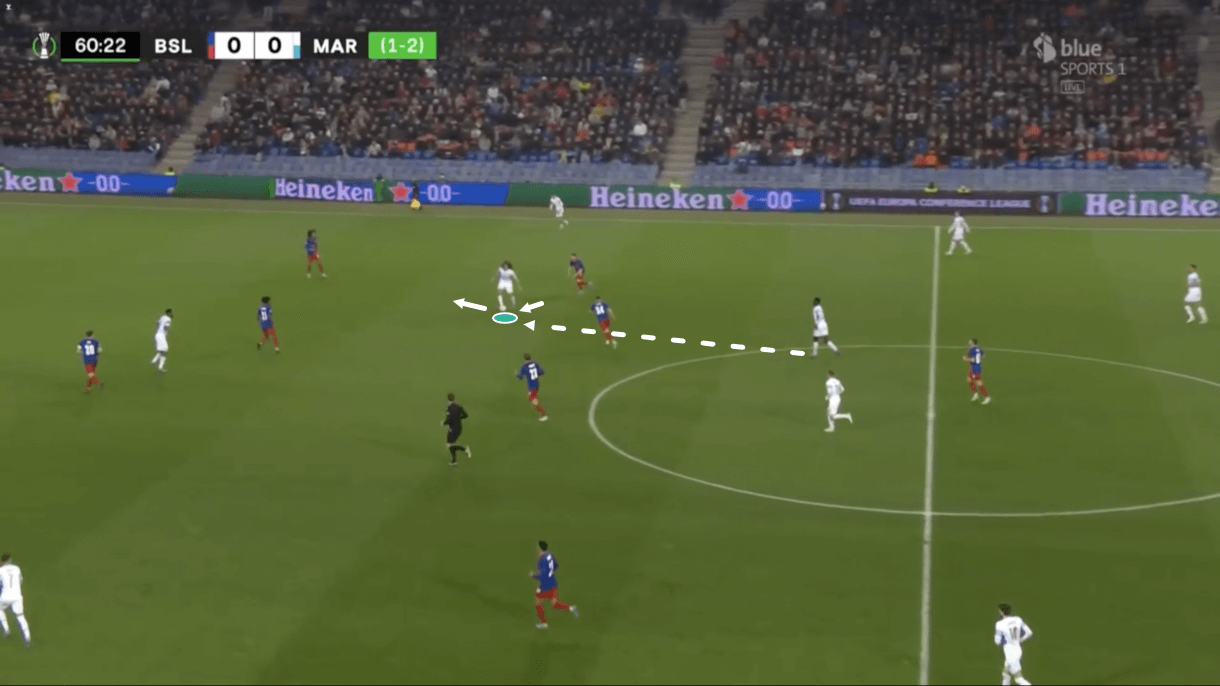
It’s also worth noting how Guendouzi angles his body ahead of receiving the ball in Figure 3.
As we can see from Figure 4, this body angle helps the passer know where the midfielder wants the pass played and allows Guendouzi to take the ball on the half-turn before starting to drive at the opposition’s backline.
It’s common to see Guendouzi receive like this.
It’s an important part of his game to be able to receive on the half-turn, as he often has to receive from deeper players with his back to goal.
In his role as a link between the deeper players and the more advanced players, he must be able to facilitate quick and effective progression, which this ability to receive the ball so well ensures.
At this point, the forwards ahead of Guendouzi must be thinking about where to make their run, as the midfielder needs runners ahead of him to split the opposition’s backline and send his team through on goal.
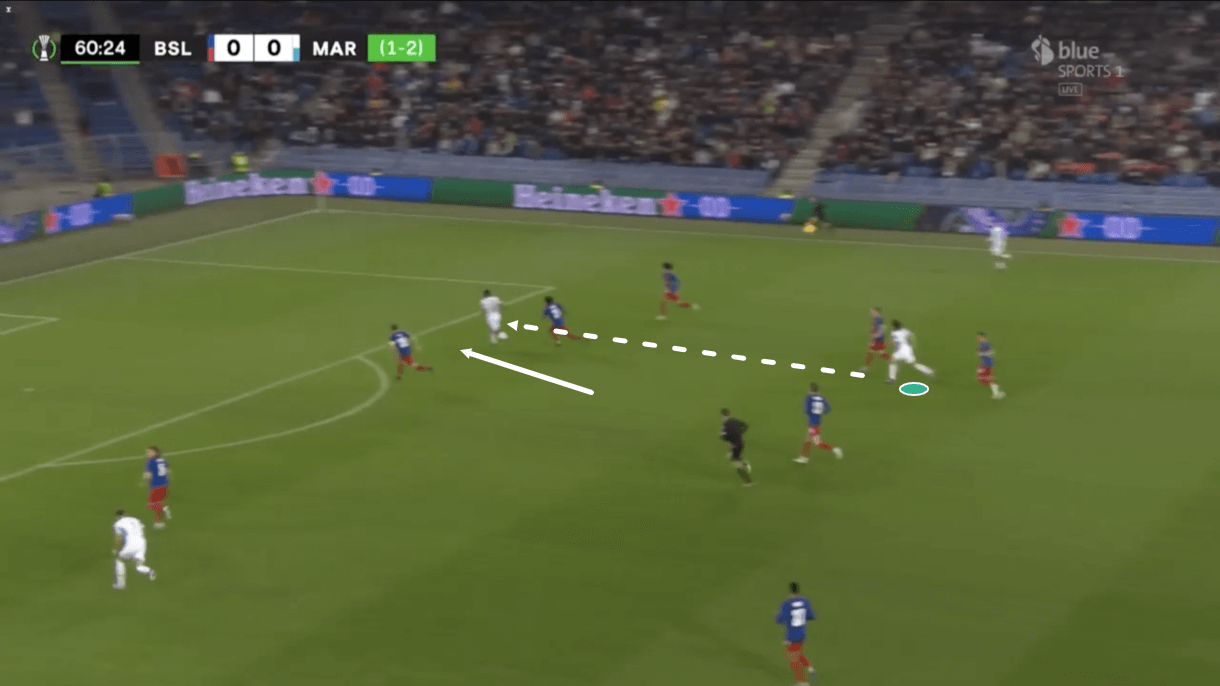
The run from the nearest forward to Guendouzi is made from in-to-out, giving the 22-year-old a chance to split the opposition’s backline with a fairly straight through ball.
As we see from Figure 5, this combination of pass and run successfully breached the opposition’s backline, and Guendouzi was able to set this attacker up for a dangerous goalscoring opportunity, helping him progress into the box.
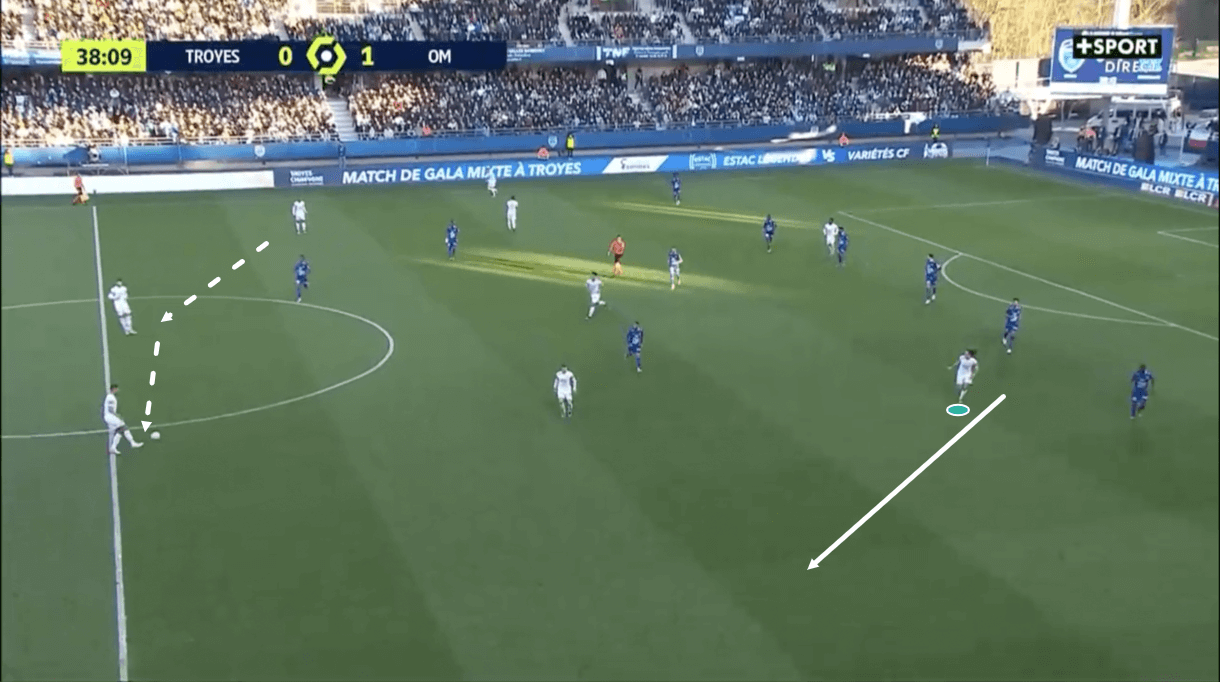
Guendouzi doesn’t just back off defenders into space behind him — he looks to exploit space wherever it’s possible, and figures 6-7 show an example of the midfielder dropping into a deeper area of the pitch to achieve this.
This particular example also shows how Guendouzi’s movements, and probably instructions, change depending on the opponent, with Marseille always looking to exploit different teams in different ways.
In figures 3-5, we saw Guendouzi peeling off the midfielder’s shoulder to exploit space between the lines but here in figure 6, we see the midfielder dropping deeper and wider to exploit space deep in the right half-space.
This game versus Troyes featured Sampaoli’s side against a 5-3-2, and the 5-3-2 shape often tends to be weakest in these deep half-space positions.
The opposition’s midfield is typically stretched easier with just three bodies in there and only the wing-back responsible for covering the entire length of the wing.
Guendouzi intelligently exploited this weakness by dropping deeper rather than shifting higher when looking to receive a pass from his deeper-lying teammate.
Whether it’s further upfield or deeper, Guendouzi is always looking to find and exploit space where he can be a useful passing option for his teammates.
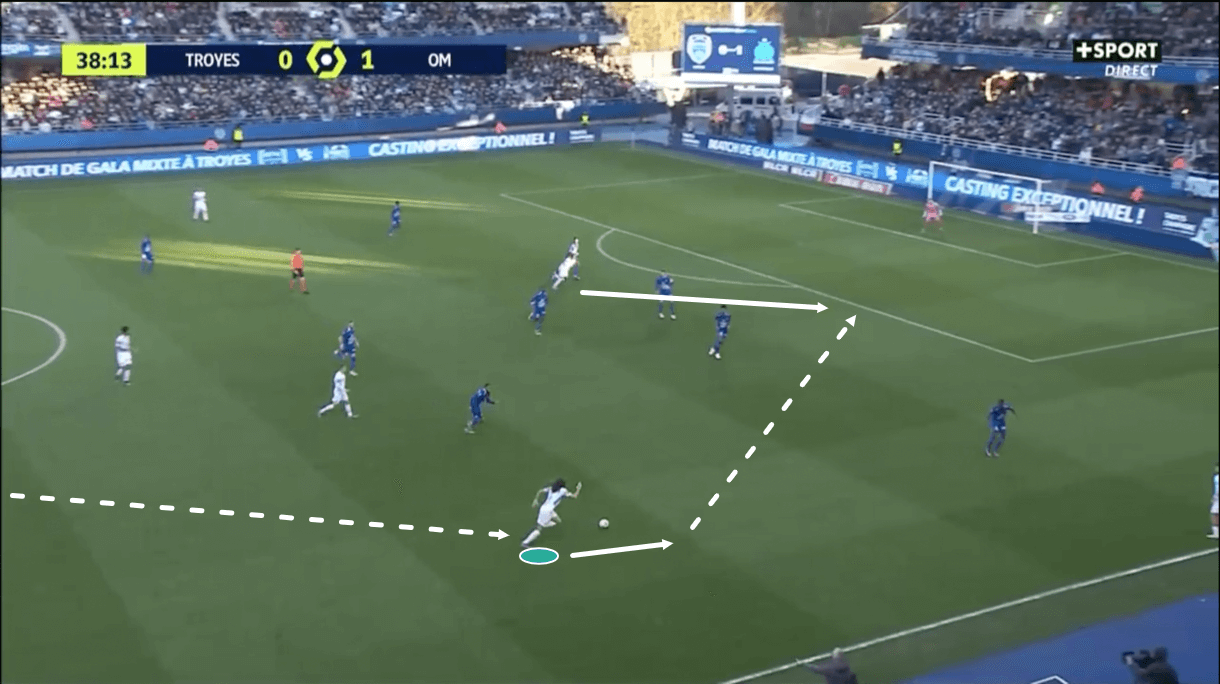
In Figure 7, after receiving the pass in plenty of space, Guendouzi was able to turn and aim for a teammate’s run in behind the opposition backline with another through ball aiming between the right centre-back and right wing-back, similar to the space we saw him targeting in Figure 5.
On this particular occasion, the through pass was very well intercepted by the right centre-back, but we can see his intent from this example.
It also provides an excellent example of Guendouzi’s off-the-ball movement to find and exploit space before turning and aiming to drive his team forward.
A few other notable metrics for Mattéo Guendouzi style of play that are linked to his performance in chance creation are that, among Ligue 1 midfielders for 2021/22, he lies in the 89th percentile for passes into the final third, the 95th percentile for passes into the penalty area and the 94th percentile for progressive passes — the latter while not being particularly active in the early possession phases when progressive passes are very often made.
Furthermore, Guendouzi’s 6.31 progressive passes per 90 rank him joint-second in that metric among Marseille players, while his 6.23 passes into the final third rank him second in that particular passing metric among his teammates this season, too, per Statsbomb via FBRef.
So, his standout performances in terms of driving his team forward from around the edge of the final third into the more advanced areas within the final third are clear.
This is a particularly important aspect of his game under Sampaoli.
As we’ve seen from these examples, he loves to drive his team forward from the right half-space. Guendouzi was particularly active and productive in this position in 2021/22.
Mattéo Guendouzi Carrying
Ball-carrying is another very important part of Guendouzi’s game in possession.
It is also another major way the midfielder creates good opportunities for himself to play opponents through on goal.
This skill has proven very effective in transition and regular possession phases for Marseille this term.
The importance of carrying within Guendouzi’s role at Marseille this season is evident in the fact that per Statsbomb via FBRef, he’s completed an average of 9.07 progressive carries per 90, which is the most of any Marseille player in 2021/22.
In addition to being Marseille’s most frequent ball carrier, the France international impressively lies in the 98th percentile for progressive carries when compared to other Ligue 1 midfielders, as well as the 95th percentile for carries into the penalty area and the 93rd percentile for carries into the final third, highlighting how he’s not just a standout in this particular area at Marseille, but among all midfielders from France’s top-flight.
His impressive performances in this area have been important for Guendouzi’s overall performance as a creator within this Marseille team.
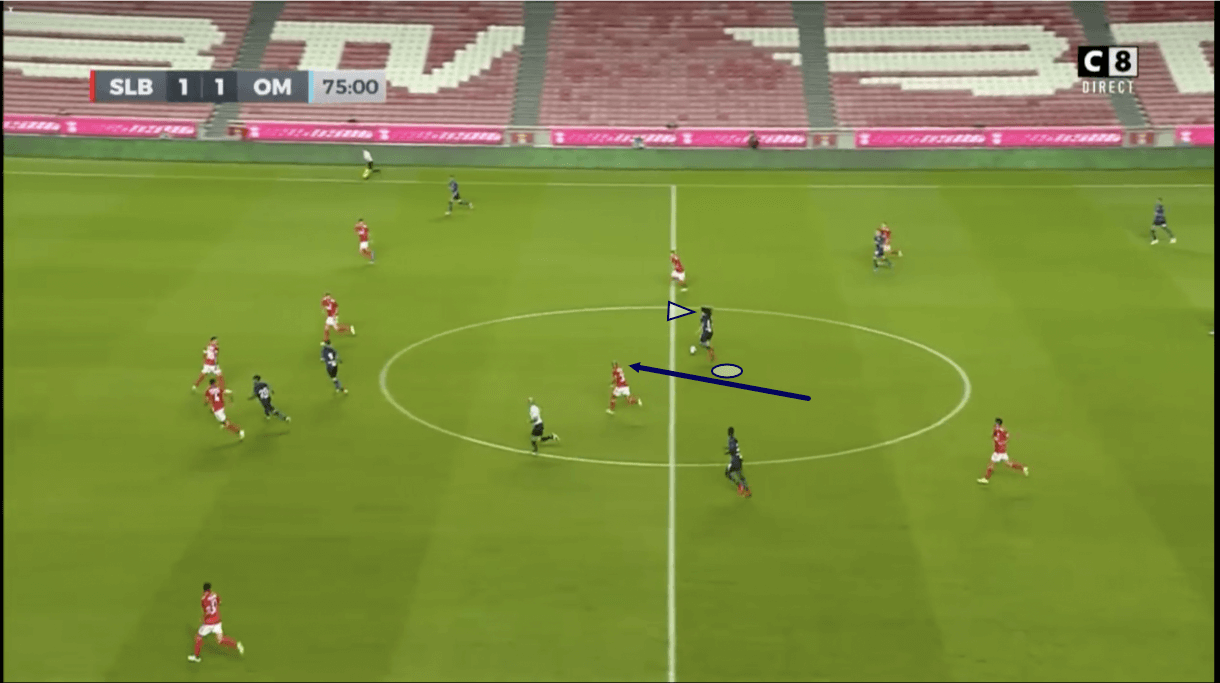
In Figure 8, we see an example of Guendouzi bursting forward with the ball at his feet after receiving a forward pass from a deeper teammate.
While running forward with the ball, Guendouzi likes to get his head up and scan for movement from teammates ahead of him, provided he has the space and time to do so, as in the image above.
On this occasion, he’s able to spot a few potential passing options while observing how the pitch is laid out ahead of him.
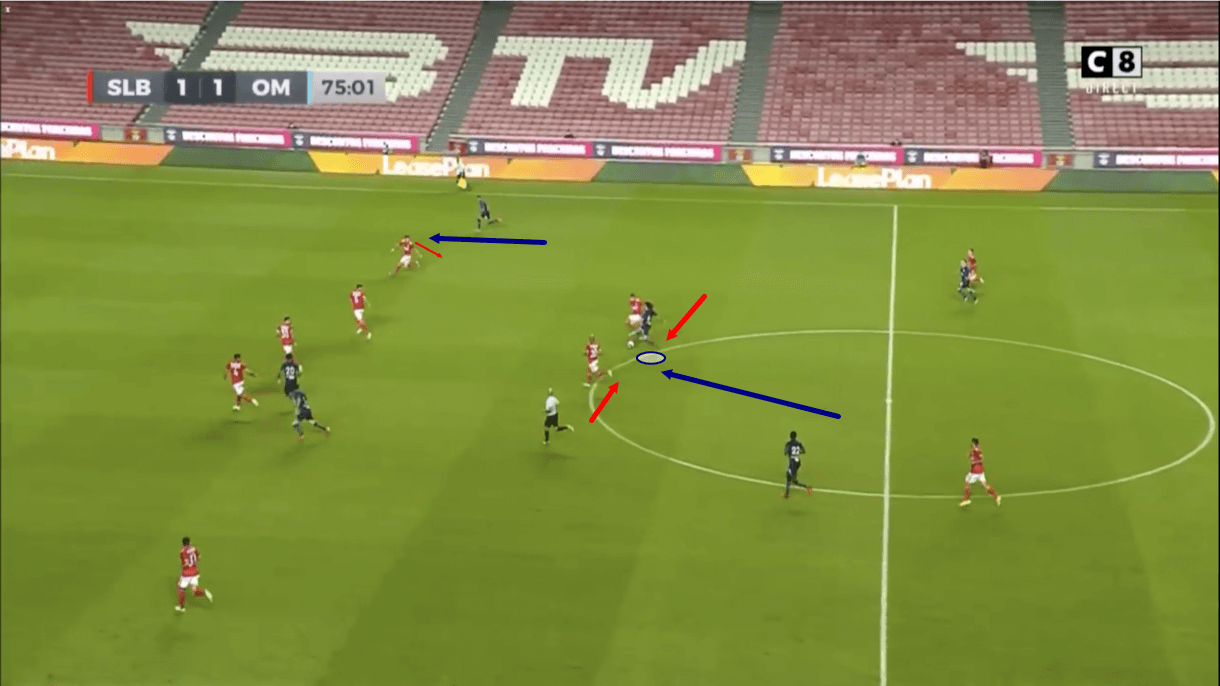
An important aspect of Guendouzi’s ball-carrying ability is that it often draws multiple opposition players towards him, both physically and mentally.
As a result, these players are obviously drawn away from the Frenchman’s teammates, giving them more space in which to receive Guendouzi’s incoming pass.
This ‘gravity’ is an important aspect of Guendouzi’s game, given he carries the ball so much for Marseille.
He’s often tasked with creating space for teammates in this way, as we see in Figure 9.
Here, the two nearest opposition midfielders to either side of Guendouzi are drawn towards him but notably, the Marseille man also attracts attention from the opposition left-back.
This split second of attention from the opposition left-back gives Guendouzi and Marseille’s right-winger the chance to exploit that player.
The ball carrier spots this player thanks to his excellent vision and awareness of what’s going on around him.
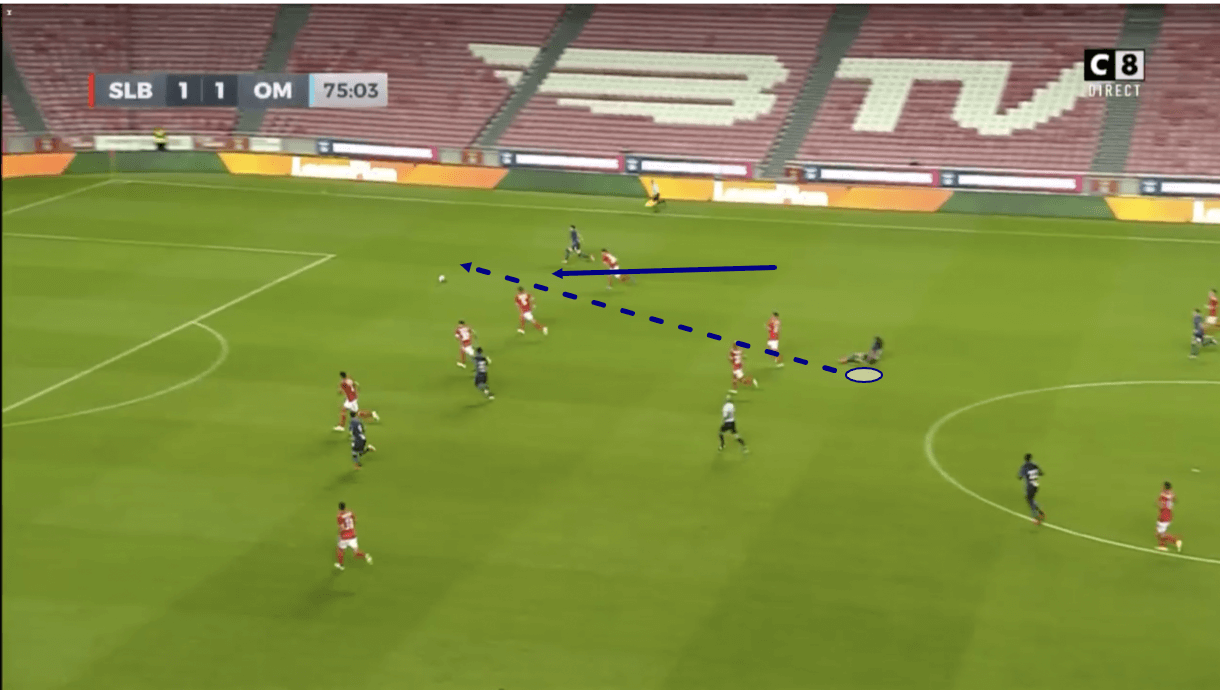
As the play progresses into Figure 10, we see how the right-winger timed his run perfectly, and Guendouzi also timed his through pass perfectly to link up with this player looking to exploit space behind the opposition full-back.
The left-back was slowed by the fact that he turned a bit too much to focus on Guendouzi in figure 9, as he had to turn back around again to chase the winger Guendouzi played the ball through to with an exquisitely well-weighted pass in figure 10.
Here, we see an example of how Guendouzi’s technical carrying ability can combine with his vision and awareness, as well as, ultimately, his technical passing quality to exploit space behind the opposition’s backline.
This is a very important and effective aspect of Marseille’s performance in the chance creation phase.
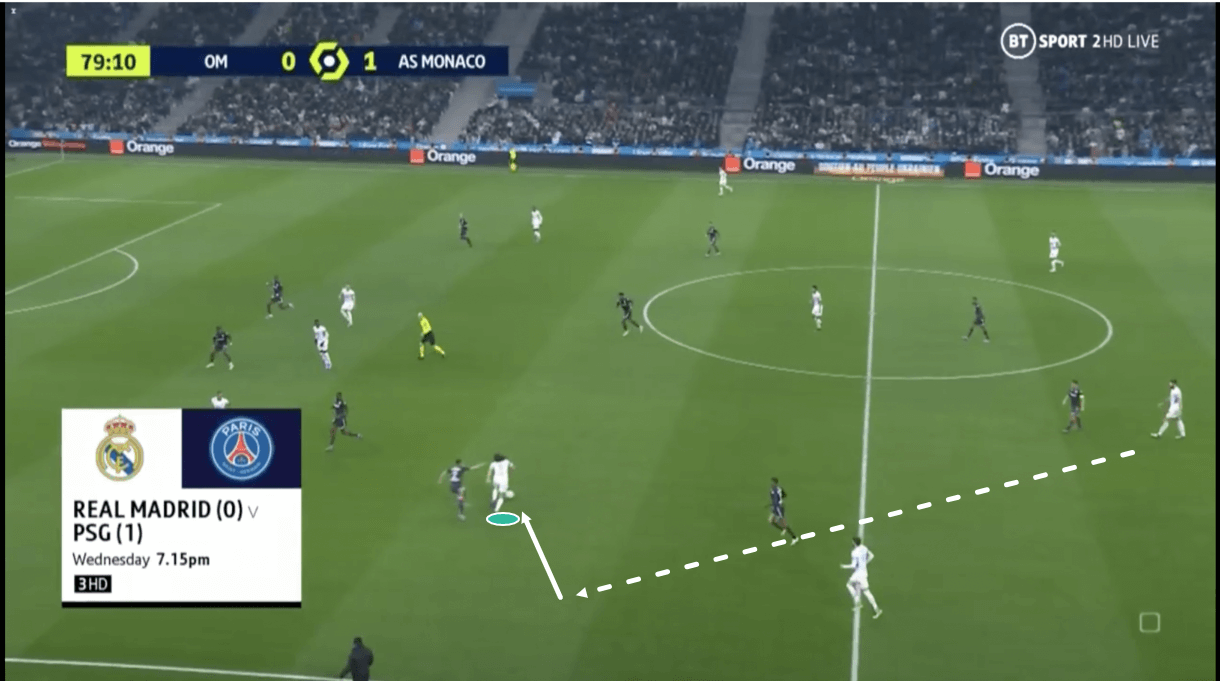
In addition to directly creating chances for teammates via passes as a result of these carries, Guendouzi draws many fouls from opposition players due to his high volume of carries.
Drawing fouls like this can be a very useful ability, especially if a team is intelligent and creative with their set-piece routines, as set-pieces can be extremely valuable.
Guendouzi draws fouls in a way that is very similar to how he draws physical opposition players towards him, as we saw in the previous passage of play we analysed.
Figures 11-12 will show an example of how Guendouzi draws fouls via his carries.
Starting with Figure 11, just before this image, the midfielder receives the ball from his teammate out wide on the left wing.
The Frenchman has played on the left instead of the right in this particular fixture.
After receiving this pass, Guendouzi started carrying the ball inside, aiming to drive into the centre, from where he could have more passing opportunities and where there was more space available at this particular moment in the game.
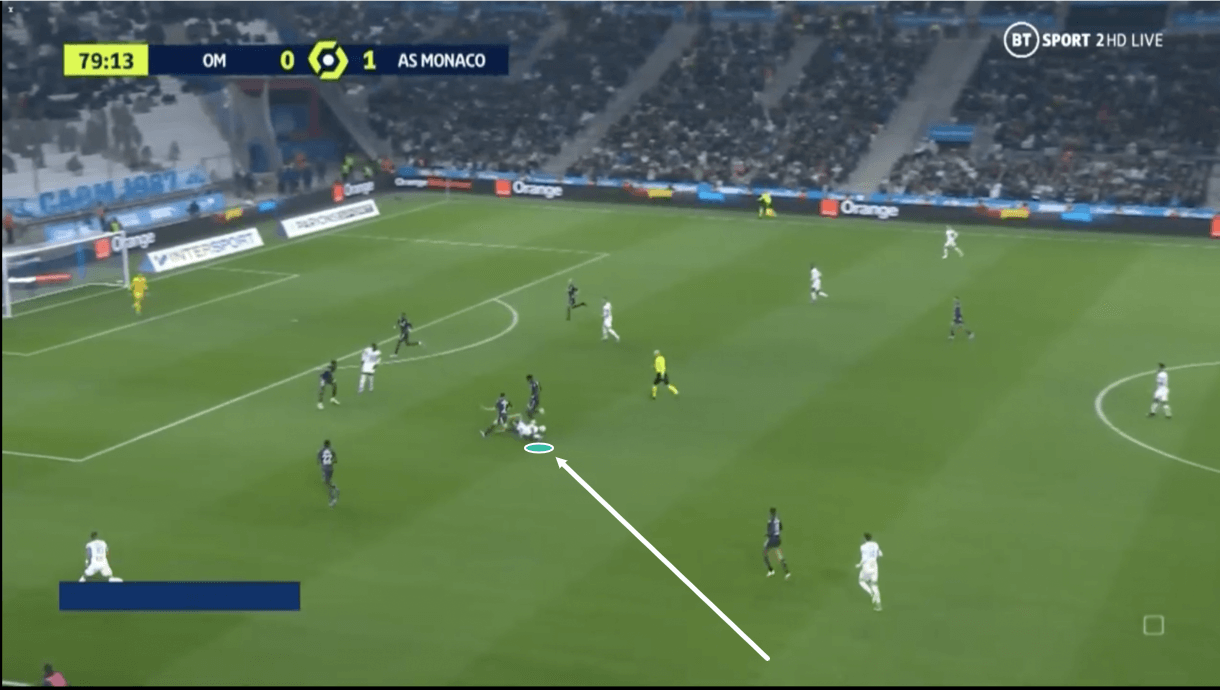
Moving on into figure 12, we can see how a couple of opposition players were drawn towards Guendouzi as a result of this threatening run into a more central area of the pitch and due to the fast-paced nature of the game, as well as Guendouzi’s efforts to protect the ball by keeping himself between it and the opposition defenders, some contact was forced by the ball-carrier which led to him going down, resulting in a free-kick inside the final third for Marseille.
So, from this in-game example, we see how Guendouzi’s ball-carrying ability took his time into a far more valuable position than they were in when he picked up the ball and earned Les Olympiens a free-kick in this much more valuable position.
This shows how valuable the Frenchman’s ball-carrying ability can be, especially his ability to draw fouls from the opposition.
It’s evident that this ability is a critically important aspect of his performance in the chance creation phase—similar to his off-the-ball movement, which we analysed in the previous section of analysis.
Mattéo Guendouzi Defensive responsibilities
Guendouzi isn’t a great asset to the team defensively, and this is undoubtedly a weak area of his game that could use some improvement.
The player can improve both technically and physically on the defensive side, as well as in terms of his defensive work rate.
This Sampaoli team doesn’t press with crazy intensity at all times, they’re actually quite calculated in how and when they press.
They are, however, very active in counter-pressing, and Guendouzi also comes alive in this part of their game.
The Argentinian coach has managed to extract energy from the 22-year-old in limited bursts by maximising his involvement in counter-pressing.
Again, it must be said that Guendouzi doesn’t offer much to his side in the defensive phases.
Of course, if you had a more defensively active or defensively capable player on the team in his place, this would likely make Marseille an even better defensive unit.
Still, we’re talking about the team with the second-best defensive record in terms of goals conceded out of all Ligue 1 sides here, trailing only Christophe Galtier’s Nice, who you can read about here in my second-most recent analysis piece for Total Football Analysis.
Guendouzi’s contribution has been quite sufficient.
The counter-press is an excellent tool for Marseille both in terms of defence, shutting down opposition counter-attacks early, and in terms of attack, as winning the ball back close to the opposition’s goal can create excellent counter-attacking opportunities from dangerous positions for Les Olympiens.
According to Statsbomb via FBRef, Guendouzi ranks in the 68th percentile among Ligue 1 midfielders in 2021/22 for pressures in the attacking third (a substantial jump from the 11th percentile and 2nd percentile for the middle third and defensive third, respectively) and ranks in the 64th percentile for successful pressure % (though just the 6th percentile for pressures per 90).
This further supports the point that Guendouzi isn’t particularly active overall in defensive phases but is active in limited bursts, which sees him jump into action when required to counter-press.
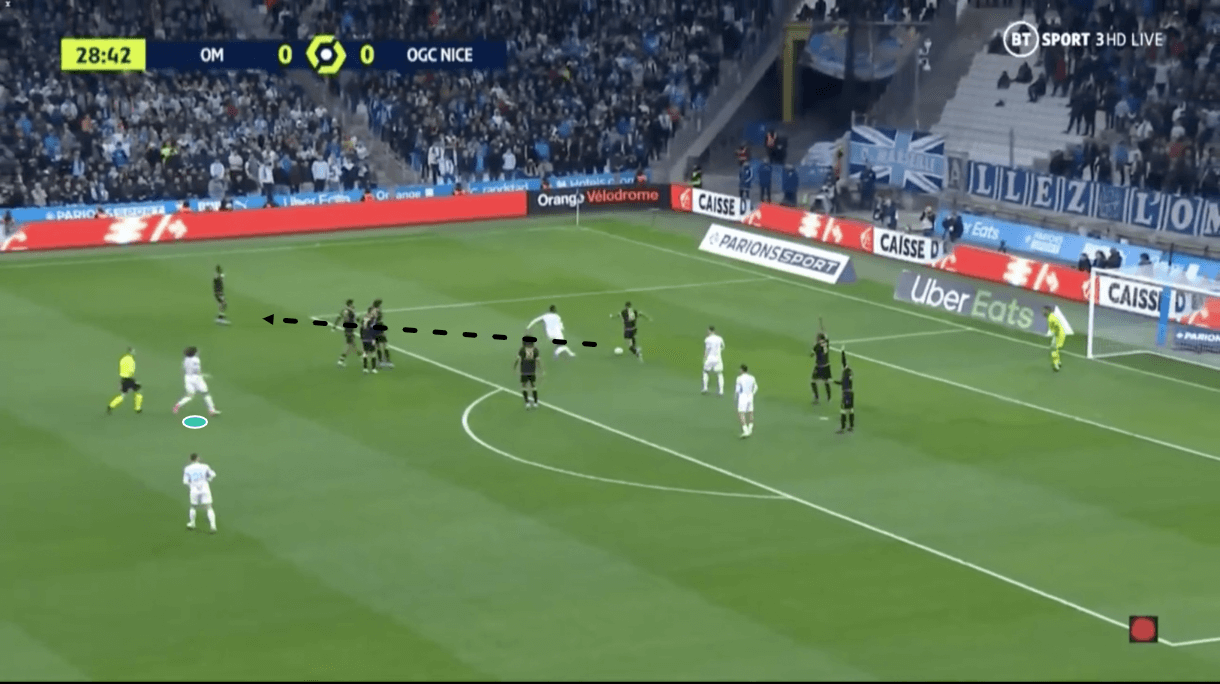
Figure 13 shows an example of one counter-pressing situation in which Guendouzi played an important role for Marseille.
Just before this image, Marseille lost the ball inside the opposition’s box, with the dribbler nearest to the ball getting dispossessed.
This led to the opposition defender we see on the ball retaking possession for his side and subsequently sending the ball out to the free man occupying the right-back position.
As soon as this turnover occurs, so does Marseille’s counter-press, with the attacker who was dispossessed charging down the ball carrier and other Marseille players also beginning to jump into action from their rest-defence structure (which you can read about in the earlier-mentioned Sampaoli at Marseille 2021/22 tactical analysis).
Guendouzi’s position is worth noting here as the turnover occurs.
He’s not typically occupying a position in his team’s highest line, rather the one behind this line.
This helps him operate in his preferred role as a creator, with runners ahead of him behind the most advanced line, but it also requires him to be alert and active during transitions.
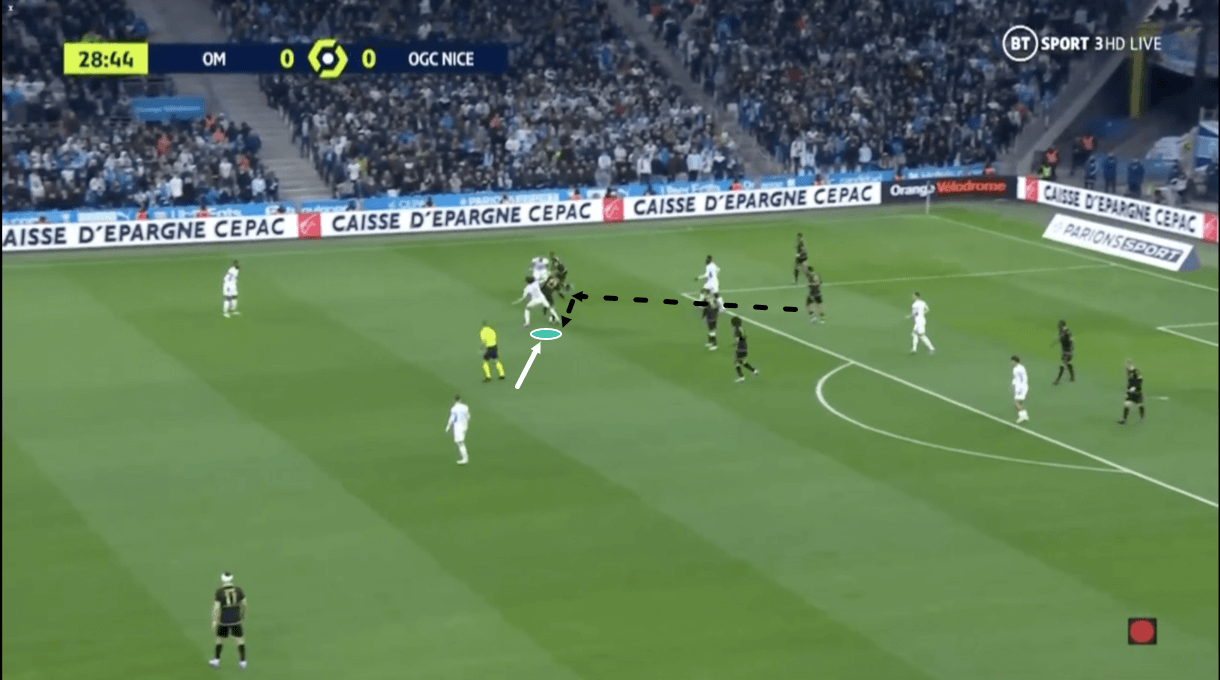
As play moves on into Figure 14, we see how Marseille’s wide defender closed down the receiver from the centre-back’s pass, leaving the pathway into the nearest central midfielder open.
Under pressure, the opposition’s passer played the ball to this man in midfield.
However, Guendouzi was alert to this danger and was right on the player’s back as he received the ball, preventing him from turning and putting him into a very difficult situation, now outnumbered by Marseille shirts breathing down his neck from all angles.
After this point, Guendouzi successfully knocks the ball away from this player, regaining possession for Marseille quickly and efficiently inside the final third.
This creates an excellent opportunity to hit Nice in transition themselves just moments after it looks as though their own defence may be threatened by a Nice counter.
This is just one example of Marseille’s counter-pressing, which has been an important part of their success this season.
The midfielders in Sampaoli’s system, Guendouzi included, have an important role in making this work.
As we see from this passage of play, the Frenchman, though not his team’s most defensively active player, has a lot to offer his side in this area and has performed well this term.
That said, I’ll reiterate that Guendouzi could do so much more for his side in the defensive phases.
This particular example and his entire performance off the ball this season just scratch the surface of what he could be capable of with more work and attention to his defensive abilities.
Furthermore, Guendouzi and his overall lack of defensive ability/effort could be exploited by opposing teams.
I’m not suggesting he should prioritise it over making up some more ground on his strengths, of which there are many, but some improvement would be helpful for his side.
Conclusion
To conclude this tactical analysis and scout report looking at Guendouzi at Marseille this term, it’s clear that Sampaoli has aimed to accentuate his 22-year-old asset’s attacking and creative qualities this term by utilising him as a creative force in the upper-middle / lower-attacking thirds of the pitch.
This has led to Guendouzi putting up the best numbers of his career in 2021/22 thus far, and I hope this scout report has highlighted both the tactical role/instructions and the individual qualities that have made this possible, along with some areas for further growth as the 22-year-old continues his development.





Comments